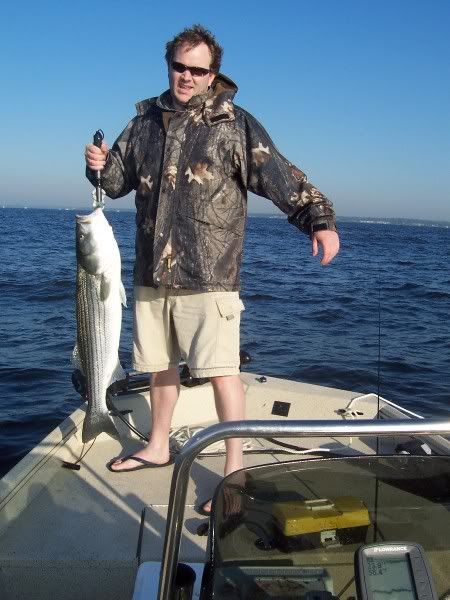Striped b [no swearing please] are members of the temperate b [no swearing please] family which include white perch and white bass.
General information
The striped bass, also known as rockfish south of New Jersey, can be found all along the Atlantic coast from Florida to Nova Scotia. Striped b [no swearing please] are a popular game fish and they are much venerated among surf fishermen. They can grow quite large: the world record striped b [no swearing please] caught on rod and reel is 78 lb 8 oz (35.6 kg). It was landed from a jetty in Atlantic City, NJ by Albert McReynolds. He was fishing a Rebel Windcheater during a stormy, fall night in 1982. The largest female b [no swearing please] ever caught in a bay was 76 pounds. There have been reports of striped b [no swearing please] netted weighing 125 lb (57 kg). However this was during the ( 1700s ? not sure about the date). There has not been so large a fish recorded in recent history, however these accounts indicate the growth potential that striped b [no swearing please] possess.
[edit]
Life cycle
Striped b [no swearing please] breed in freshwater and spend their adult lives in saltwater. They can also live exclusively in freshwater and currently flourish in inland water bodies such as Lake Powell and Lake Mead. For saltwater striped bass, four important bodies of water with breeding stocks of striped b [no swearing please] are: Chesapeake Bay, Massachusetts Bay/Cape Cod, Hudson River and Delaware River. There are many smaller breeding areas that contribute to the overall striped b [no swearing please] population such as the Takanasse Lake. It is believed that many of the rivers and tributaries that emptied into the Atlantic, had at one time, breeding stock of striped bass. One of the smaller breeding areas is the Chesapeake and Delaware Canal, where populations from Chesapeake and Delaware bays have intermingled.
General information
The striped bass, also known as rockfish south of New Jersey, can be found all along the Atlantic coast from Florida to Nova Scotia. Striped b [no swearing please] are a popular game fish and they are much venerated among surf fishermen. They can grow quite large: the world record striped b [no swearing please] caught on rod and reel is 78 lb 8 oz (35.6 kg). It was landed from a jetty in Atlantic City, NJ by Albert McReynolds. He was fishing a Rebel Windcheater during a stormy, fall night in 1982. The largest female b [no swearing please] ever caught in a bay was 76 pounds. There have been reports of striped b [no swearing please] netted weighing 125 lb (57 kg). However this was during the ( 1700s ? not sure about the date). There has not been so large a fish recorded in recent history, however these accounts indicate the growth potential that striped b [no swearing please] possess.
[edit]
Life cycle
Striped b [no swearing please] breed in freshwater and spend their adult lives in saltwater. They can also live exclusively in freshwater and currently flourish in inland water bodies such as Lake Powell and Lake Mead. For saltwater striped bass, four important bodies of water with breeding stocks of striped b [no swearing please] are: Chesapeake Bay, Massachusetts Bay/Cape Cod, Hudson River and Delaware River. There are many smaller breeding areas that contribute to the overall striped b [no swearing please] population such as the Takanasse Lake. It is believed that many of the rivers and tributaries that emptied into the Atlantic, had at one time, breeding stock of striped bass. One of the smaller breeding areas is the Chesapeake and Delaware Canal, where populations from Chesapeake and Delaware bays have intermingled.








